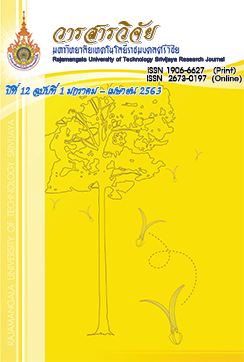Investigation of Piper Betle Herbal Tea Drying with Infrared Heater by Solar Cell Power
Keywords:
Piper Bitle Leave, herbal drying, solar cell power, infrared heaterAbstract
Drying of agricultural materials is food processing and preservation. There are many methods to dry herb. This research aimed to study the Piper Betle herbal tea drying. The drying process of this herbal applied a 350-watt infrared heater as a heating dryer device. The 100-watt solar cell power was used with 100-ampere, 12-volt of battery. The solar energy system was not connected to the electric grid (off grid system). The herbal drying was able to use electric grid directly when the solar system does not produce electricity. In the experiment, 200 grams of Piper Betel leaves were used for drying. At the drying temperature of 50, 55 and 60 degree Celsius, the drying time was 3, 5 and 7 hours. It was found that the moisture content of the Piper Betle leaves sharply decreased under the drying condition of 180 minutes (3 hrs.) at 60 degree Celsius. The solar batteries were be able to used for 90 minutes with each fully charged and the moisture content of Piper Betel herbal tea after drying was less than 5 percent.
References
นักสิทธิ์ ปัญโญใหญ่, สุดธิดา คำเหมือง และ วิภาวรรณ ไชยเทพ. 2554. การศึกษารูปแบบการอบแห้งสมุนไพรไทยบางชนิด. แก่นเกษตร (ฉบับพิเศษ) 39: 488-492.
บงกช ประสิทธิ์, สหัถยา ทองสา และ พิสิษฏ์ มณีโชติ. 2557. การพัฒนาเครื่องอบแห้งพลังงานแสงอิทตย์แบบอุโมงค์ร่วมกับเซลล์แสงอาทิตย์เพื่อการผลิตไฟฟ้าให้กับพัดลมในอุโมงค์อบแห้งสำหรับพื้นที่ไฟฟ้าเข้าไม่ถึง. วารสารวิศวกรรมและเทคโนโลยี มหาวิทยาลัยรังสิต 17(1): 19-41.
แบงค์ ศรีสุข และ วิทยา ยงเจริญ. 2556. สมรรถนะของระบบผลิตไฟฟ้าและความร้อนด้วยแผงผลิตไฟฟ้าและความร้อนชนิดแผ่นเรียบรับความร้อน. วารสารวิจัยพลังงาน 10(2): 57-70.
สุภวรรณ ฏิระวณิชย์กุล, สลิลลา ชาญเชี่ยว และยุทธนา ฏิระวณิชย์กุล. 2556ก. การอบแห้งใบบัวบกเพื่อผลิตใบบัวบกแห้งชงดื่มด้วยการแผ่รังสีอินฟราเรด: จลนพลศาสตร์ ความสิ้นเปลืองพลังงานและคุณภาพ. วารสารวิจัย มข. 18(2): 311-324.
สุภวรรณ ฎิระวิณิชย์กุล, จุฑารัตน์ ทะสะระ, จุไรรัตน์ สุริยงค์, ปิยาภรณ์ ปานกำเนิด แล ะ ยุทธนา ฏิระวณิชย์กุล. 2556ข. การอบแห้งใบเตยและตะไคร้เพื่อผลิตเป็นชาชงสมุนไพรด้วยแหล่งพลังงานความร้อนหลายรูปแบบ, น. 570-577.
ใน ประชุมวิชาการสมาคมวิศวกรรมเกษตรแห่งประเทศไทย ระดับชาติ ครั้งที่ 14 และระดับนานาชาติ ครั้งที่ 6 ประจำปี 2556. สมาคมวิศวกรรมเกษตรแห่งประเทศไทย, กรุงเทพฯ.
สุวรรณ วิรัชกุล, สุสาห์ เจริญวัฒนา, สมใจ ศรีลออกุล, วิเชียร วรพุทธพร และ ประทุม สงวนตระกูล. 2531. รายงานการวิจัย การศึกษาเปรียบเทียบคุณสมบัติของผลิตภัณฑ์ที่ได้จากการทำแห้งโดยแสงแดดกับการใช้ตู้อบพลังงานแสงอาทิตย์. มหาวิทยาลัยเกษตรศาสตร์.
อรัญญา ศรีบุศราคัม. 2546. พลูกับโรคผิวหนังที่เกิดจากเชื้อรา. จุลสารข้อมูลสมุนไพร 20(3): 4-8.
อัจฉรา แซ่โค้ว, สุภวรรณ ฏิระวณิชย์กุล และ ยุทธนา ฏิระวณิชย์กุล. 2556. ปัจจัยของการอบแห้งด้วยแหล่งพลังงานความร้อนแบบการพาและการแผ่รังสีความร้อนที่มีต่อจลนพลศาสตร์และคุณภาพของพริกไทยดำ. Burapha Science Journal 18: 155-180.
Ahmad, F., Mohd, H.R., Mohd, Y.O., Omidreza, S., Azami, Z. and Kamaruzzaman, S. 2012. Investigation of Medical Herbs Moisture in Solar Drying. Advances in Environment, Biotechnology and Biomedicine : 127-131.
Ali, A. 2004. Efficiency improvement of Photo-Voltaic Panels Using ca Sun-tracking System. Applied Energy 79: 345-354.
Bala, B.K. and Janjai, S. 2009. Solar drying fruits, vegetables, spices, medicinal plants and fish: Developments and Potentials, pp. 1-24. In International Solar Food Processing Conference. The International Solar Energy Society (ISES) and funded by WISIONS Indore, India.
Li, C.M.R. and Jiau, C.H. 2009. The antimicrobial activity, mosquito larvicidal activity, antioxidant property and tyrosinase inhibition of Piper betle. Journal of the Chinese Chemical Society 56: 653-658.
Nabasree, D. and Bratati, D. 2004. Antioxidant activity of Piper betle L. leaf extract in vitro. Food Chemistry 88: 219-224.
Slobodan, B., Vangelce, M., Monika, L., Tale, G. and Vladimir, M. 2015. Experimental Investigation of Vacuum Far-Infrared Drying of Potato Slicies. Journal on Processing and Energy in Agriculture 19(2): 71-75.
Downloads
Published
How to Cite
Issue
Section
License
The content and information in the article published in Journal of Rajamangala University of Technology Srivijaya It is the opinion and responsibility of the author of the article. The editorial journals do not need to agree. Or share any responsibility.







